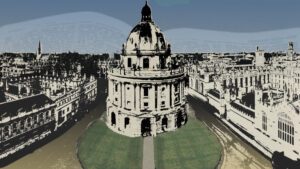This series analyzes perplexing passages of the Bible. Previously:
A friend discovered the joys of body surfing in midlife, when she and her husband moved to Southern California, within 40 miles of the beaches and breakers of the Pacific Ocean. So she was understandably troubled by Revelation 21:1 and the prospect that ocean’s azure waters and surging waves will be absent from the coming new heavens and new earth. A few verses later we read that God “will wipe away every tear from their eyes, and death shall be no more, neither shall there be mourning, nor crying, nor pain anymore, for the former things have passed away” (Rev. 21:4).
To such miseries, sin’s toxic byproducts, we say, “Good riddance!” But, we wonder, once the curse-stained first heaven and earth have given way to a new heaven and a new earth, why must the new cosmic order be sans sea, while we’ll still stand on terra firma?
Literal Interpretations of the Sea
My friend’s dismay assumes that the “sea” that will be “no more” in the new heaven and new earth is a vast body of physical water (all the oceans that blanket our present earth). That is understandable, since in Revelation, even amid its symbolic visions, “sea” should sometimes be understood “literally”—that is, physically. For example, God is to be worshiped because he created “heaven and earth, the sea and springs of water” (14:7; see also 5:13; 7:1-3; 10:2-8; 12:12). So it is not surprising that Revelation 21:1 has been understood as announcing that a large body of physical water, or all large bodies of physical water, or even physical water itself will not be present in the new earth. John Walvoord, for example, commented, “Most of the earth is now covered with water, but the new earth apparently will have no bodies of water except for the river mentioned in 22:2.”[2] John MacArthur goes further, interpreting the absence of “the sea” as implying the absence of all physical water (H2O) anywhere, in any form, on the new earth:
The sea is emblematic of the present water-based environment. All life on earth is dependent on water for its survival. . . . But believers’ glorified bodies will not require water, unlike present human bodies, whose blood is 90 percent water, and whose flesh is 65 percent water. Thus, the new heaven and the new earth will be based on a completely different life principle than the present universe. There will be a river in heaven, not of water, but of the “water of life” (22:1, 17).[3]
On the other hand, Randy Alcorn, who admits to enjoying snorkeling, is troubled by the prospect that oceans and the wonder-evoking creatures that inhabit them would have no place in consummation of God’s new creation. He suggests that the “core meaning” of Revelation 21:1 is that “there will be no more of the cold, treacherous waters that separate nations, destroy ships, and drown our loved ones. There will be no more creatures swallowing up seafarers and no more poisoned salt waters.”[4] In a cosmos purged of pollution, salt water would no longer be needed to serve as a global antiseptic, so perhaps the “sea” that is “no more” refers only to salt water oceans. In the new earth “[h]uge lakes could, in effect, be freshwater oceans,” teeming with sea life.[5]
Interpretations of the Sea Elsewhere in Revelation and Earlier in the Bible
Speculations about the absence or presence or form of physical water in the new earth are intriguing, but we do better to take seriously the symbolic genre of John’s visions. John has seen a dragon, an ancient serpent, standing on the sand of the sea (12:17). Interpreters of every eschatological school recognize that this “serpent” is not a physical reptile, actual or mythical, but a visible symbol of a corrupt, immaterial, personal creature: Satan (12:9). Rising from that sea John saw a beast emerge, having ten horns and seven heads and resembling a leopard, a bear, and a lion (13:1-2). Bible students of all varieties recognize the echoes of Daniel’s night visions of four beasts rising from the sea (Dan. 7:1-8), which “are four kings” (7:17). So they agree that the beast of Revelation 13 is not a physical monster but a symbol of a human agent or agency, an individual or a state or a system, that violently opposes God and his people. If both the dragon on the seashore and the beast from the sea are symbols, not physical monsters, why would we assume that the sea itself is a physical body of H2O?[6]
It is important to notice that the imagery in John’s visions is drawn from the Old Testament’s rich store of symbolism. It is not only Daniel 7 that presents “the sea” as a picture of the source of restless evil (see Isa. 57:20) and hostile resistance to the Creator’s orderly reign. Without endorsing the mythological concepts of their Ancient Near Eastern neighbors, Israel’s prophets evoked their imagery in passages such as Isaiah 27:1: “In that day the LORD with his hard and great and strong sword will punish Leviathan the fleeing serpent, Leviathan the twisting serpent, and he will slay the dragon that is in the sea.” The parting of the physical waters of the Red Sea at Israel’s exodus displayed his victory over greater foes than Egypt:
You divided the sea by your might;
you broke the heads of the sea monsters on the waters.
You crushed the heads of Leviathan. (Psalm 74:13-14)[7]
Throughout history the Lord wages war against the forces of evil that storm against his sovereignty and threaten to engulf his people, whether demonic powers or pagan nations:
O LORD God of hosts,
who is mighty as you are, O LORD,
with your faithfulness all around you?
You rule the raging of the sea;
when its waves rise, you still them.
You crushed Rahab like a carcass;
you scattered your enemies with your mighty arm. (Psalm 89:8-10)
The Lord’s past victories over the dragon and its sea offer hope that he will intervene to redeem his people in one future, final foe-crushing, woe-banishing triumph:
Awake, awake, put on strength,
O arm of the LORD;
awake, as in days of old,
the generations of long ago.
Was it not you who cut Rahab in pieces,
who pierced the dragon?
Was it not you who dried up the sea,
the waters of the great deep,
who made the depths of the sea a way
for the redeemed to pass over? (Isaiah 51:9-10)
By the time John’s visions reach Revelation 21:1, “the sea,” that turbulent realm from which the dragon launched its desperate assault on the offspring of the woman, is the last symbol of evil to be eliminated. The prostitute enthroned on many waters has fallen (14:8; 16:19; 17:16-17; 18:2-3). The beast from the sea, the false prophet, and the dragon have been consigned to the lake of fire (19:20; 20:10). Now, at last, as a new heaven and new earth appear, “the sea” itself is “no more.” Gregory Beale notes that the parallel wording of Revelation 21:1 and 21:4 shows that “the sea is no more” previews the fact that death “will be no more,” and mourning and crying and pain “will be no more” in the consummated new creation. The convergence of allusions to Isaiah 51:10-11 (the Lord’s triumph over the sea) and to Isaiah 65:16-19 (the new heavens and earth, replacing “the former things,” weeping and crying) leads Beale to conclude, “in all likelihood, ‘sea’ is figurative for old-world threats. Therefore, the presence of a literal sea in the new creation would not be inconsistent with the figurative exclusion of the sea in 21:1.”[8]
Avoiding Speculation
It is tantalizing to try to imagine what life will be like in the new heavens and the new earth, where every evil, misery, sorrow, and danger “will be no more.” Will there still be waterfalls and waves, puddles and ponds, lakes and even oceans? We infer that the new earth will be material because Jesus’s resurrection body, the “sample” of that coming cosmos that has invaded human experience in this age, could be touched and ingest fish and, presumably, “the fruit of the vine” (Luke 24:36-43; Matt. 26:29).
But “the sea was no more” in Revelation 21:1 is not intended to answer our questions about opportunities to surf or snorkel or sail on the new earth. Instead, it conveys good news: our divine Champion will come to destroy our every enemy, to wipe away our every tear, and to eliminate every realm of restless rebellion, securing for all eternity our joyful, holy communion with God, who will make his dwelling with us forever (Rev. 21:3).
[1] Scripture quotations are from the English Standard Version.
[2] John F. Walvoord, The Revelation of Jesus Christ: A Commentary (Chicago: Moody, 1966), 311.
[3] John MacArthur, Revelation 12-22 (Chicago: Moody, 2000), 263. Emphasis original.
[4] Randy C. Alcorn, Heaven (Wheaton: Tyndale, 2004), 265.
[5] Ibid., 266.
[6] John also sees a prostitute “seated on many waters,” which represent “peoples and multitudes and nations and languages” (Rev. 17:1-3, 15). So abundant waters—like those that constitute seas—have already appeared as symbols in Revelation.
[7] See also Ps. 77:16-20; 114:1-6.
[8] G. K. Beale, The Book of Revelation: A Commentary on the Greek Text (Grand Rapids: Eerdmans , 1999), 1042-43. Emphasis added.
“The Most Practical and Engaging Book on Christian Living Apart from the Bible”
 “If you’re going to read just one book on Christian living and how the gospel can be applied in your life, let this be your book.”—Elisa dos Santos, Amazon reviewer.
“If you’re going to read just one book on Christian living and how the gospel can be applied in your life, let this be your book.”—Elisa dos Santos, Amazon reviewer.
In this book, seasoned church planter Jeff Vanderstelt argues that you need to become “gospel fluent”—to think about your life through the truth of the gospel and rehearse it to yourself and others.
We’re delighted to offer the Gospel Fluency: Speaking the Truths of Jesus into the Everyday Stuff of Life ebook (Crossway) to you for FREE today. Click this link to get instant access to a resource that will help you apply the gospel more confidently to every area of your life.





























